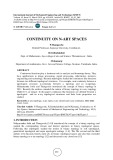
650
International Journal of Mechanical Engineering and Technology (IJMET)
Volume 10, Issue 03, March 2019, pp. 650-659. Article ID: IJMET_10_03_068
Available online at http://www.iaeme.com/ijmet/issues.asp?JType=IJMET&VType=10&IType=3
ISSN Print: 0976-6340 and ISSN Online: 0976-6359
© IAEME Publication Scopus Indexed
CONTINUITY ON N-ARY SPACES
P.Thangavelu
Retired Professsor, Karunya University, Coimbatore.
R.Seethalakshmi
Dept. of Mathematics, Jaya collage of arts and Science, Thiruninravuir - India.
M.Kamaraj
Department of mathematics, Govt. Arts and Science Collage, Sivakasi- Tamilnadu, India.
ABSTRACT
Continuous functions play a dominant role in analysis and homotopy theory. They
have applications to image processing, signal processing, information, statistics,
engineering and technology. Recently topologists studied the continuous like functions
between two different topological structures. For example, semi continuity between a
topological structure, α-continuity between a topology and an α-topology.
Nithyanantha Jothi and Thangavelu introduced the concept of binary topology in
2011. Recently the authors extended the notion of binary topology to n-ary topology
where n˃1 an integer. In this paper continuous like functions are defined between a
topological and an n-ary topological structures and their basic properties are
studied.
Keywords: n-ary topology, n-ary open, n-ary closed and n-ary continuity. MSC 2010:
54A05, 54A99.
Cite this Article: P.Thangavelu, R.Seethalakshmi and M.Kamaraj, Continuity on N-
Ary Spaces, International Journal of Mechanical Engineering and Technology, 10(3),
2019, pp. 650-659.
http://www.iaeme.com/IJMET/issues.asp?JType=IJMET&VType=10&IType=3
1. INTRODUCTION
Nithyanantha Jothi and Thangavelu [5-10] introduced the concept of a binary topology and
studied the corresponding closure and interior operators in binary topological spaces.
Following this topologists studied the notion of binary topology in soft topological,
generalized topological and supra topological settings {1-4]. The The second and the third
authors [11] discussed nearly open sets in binary topological spaces and also they extended
binary topology to n-ary topology [12] and discussed n-ary closed sets [13]





















